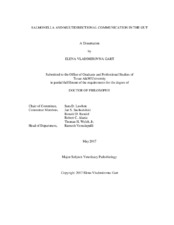| dc.description.abstract | Salmonella enterica serovar Typhymurium (S. Typhimurium) is a bacterial pathogen which is a cause of over a million cases of gastrointestinal illness worldwide. The GI tract is a large and complex environment influenced by both the host and microbes which inhabit the host’s gut. In the gut S. Typhimurium employs various virulence factors such as SPI-1 and SPI-2 to attach to the epithelial cells and persist in the body. It also initiates host inflammatory responses by inducing production of reactive oxygen species and inflammatory cytokines. Additionally, S. Typhimurium uses unique metabolic pathways to compete for limited nutrients under inflammatory conditions and during the initial colonization stage. Some members of the resident microbiota can exacerbate S. Typhimurium-induced pathology by providing necessary substrates to the pathogen and by degrading host defense mechanisms. The dense and diverse gut microbiota utilizes a variety of signaling molecules for intra- and inter-species communication to coordinate its members. Resident microbiota can also communicate with the central and enteric nervous system through neural, endocrine, immune and humoral pathways. This brain-gut communication is involved in the regulation of host and microbiota and is greatly affected by stress. While S. Typhimurium regulates gene expression by self-produced quorum sensing molecules, such as AI-2 and AI-3, it also recognize signals produced by other microbes and the host in order to regulate its growth and virulence, and in some cases, antimicrobial resistance. In the healthy gut, resident microbiota provides colonization resistance, however inflammation shifts the balance between the pathogen and microbiota thus contributing to the S. Typhimurium blooms. In summary, S. Typhimurium employs multiple tactics to establish itself in the gut; however, the microbial composition, and existing inflammatory and neural-hormonal processes also play roles in the development of the S. Typhimurium infection. This dissertation discusses the multidirectional interactions of S. Typhimurium, host and microbiota. | en |


